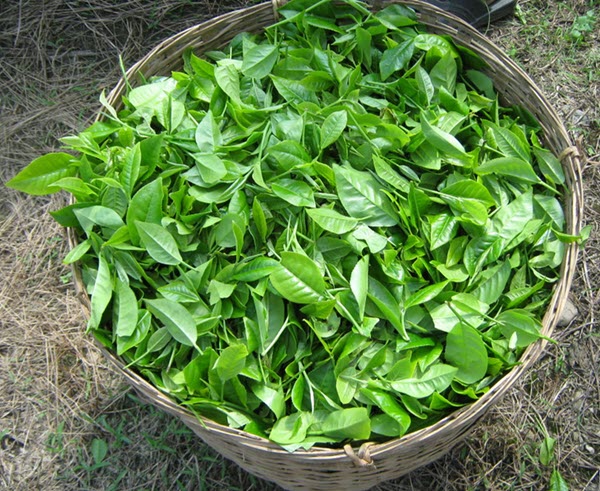Mechanical harvesting gets a bad rap. This is because poorly trained operators using poorly maintained equipment damage bushes, lowering yield and leaf quality. Simple routines such as level trimming in one direction, in a single long sweep over only half the plucking plain produces excellent leaf. Innovations like creating a seasonal calendar to regulate plucking rounds and paying workers for the area they shear instead of by the kilo keep yields high. Smallholders sharing equipment to save time can then use the many hours of labor saved for field maintenance and to complete agricultural chores like pruning, mulching, and weed abatement to deliver leaf of exceptional quality to factories.
Listen to the interview

How to Stay on Top of Plucking Rounds
Harkirat (Harki) Sidhu, 72, Rainforest Alliance India’s Consulting Program Coordinator for Sustainable Landscapes & Livelihoods and owner of Technologies Outsourcing is an expert in mechanical tea harvesters. He makes a compelling argument for improving tea quality using labor hours gained on farms that invest in these time-saving machines.

Dan Bolton: Let me begin by just asking why we need harvesters?
Harkirat Sidhu: In most geographies where we are harvesting tea, we are running out of workers who will work on farms. As a result, what happens is fewer plucking rounds that lead to tea overgrowth, and with overgrowth, you’re not going to make quality tea. So, we need to make sure that we stay on top of the plucking rounds.
The fear that people have is that if you bring in mechanical harvesting, you’re replacing labor. But that’s not the idea. The idea is to plug the gap. The labor shortage in some places will be 40%. Another place there’ll be 25% fewer workers than required, but whatever the gap is, mechanical harvesting will plug that gap. That’s the whole idea of mechanical harvesting. Without that, we cannot manage today. The more you look at Sri Lanka, at Indonesia, India, China everywhere, everywhere we got the issue of a shortage of skilled labor coming up.
“Mechanical harvesting is required today because we cannot complete plucking rounds frequently enough by hand. We need mechanical harvesting in addition to hand plucking, not to replace hand plucking.”
– Harki Sidhu
Dan: How does harvesting by machine impact the tea bushes and processing?
Harki: Mechanical harvesters are not the same as hand plucking. So, we need to reorient our processing techniques and re-evaluate the actual processing of tea. Let’s talk for a moment about that. See, the difference between a harvester and hand plucking is that when hand plucking the plucker can selectively leave fresh leaf and other [maintenance] leaves.
Whenever a harvester is required, we go non-selective at a particular height. The idea is to maintain that height because you will have problems if you go up and down. That’s why we need to make sure that we change the whole way we look at harvesting.
Because it’s non-selective, we need to ensure that we pluck at the predetermined level and that there is no maintenance foliage coming into the harvest. So, for that, we need to set the table straight. If we don’t adjust these techniques, we will lose crop. You see many videos of people using harvesters, and they keep sweeping over the bush — every time you do that, you’re double cutting. And also it’s very difficult to maintain a level plucking plain. So we don’t recommend that.
Dan: Could you explain the economics of mechanical harvesters?
Harki: You don’t need a discussion on it; it is so simple. There are three basic types of harvesting. One is hand plucking which we have been doing for ages. Then shears were introduced, they are like scissors. We call them semi-mechanical harvesters. The third is, of course, the mechanical harvesters which are bigger machines. Some are operated by a single man, and some require two or more operators.
Now, if you look at the economics, the kilograms plucked per man-day by hand might give you 30 kilograms. Shear harvesting might give you 38 or 39 kilograms, but the mechanical harvester will give you 150-200 kilograms per man-day, depending on the field. So that’s the difference straight away.
There is a 20% to 23% saving in man-days if you are shear harvesting; there is a 74% to 75% saving in man-days when doing mechanical harvesting.
What is happening today is that many governments and many organizations realize the need, but a basic subsidy is required for the mechanical harvesters because they are much more expensive.
- Editor’s Note: A small Kawasaki electric hand harvester sells for around $100, a more capable electric model costs $250-$350; a one-man, gas-powered version sells for $400-$600. A two-man harvester sells for $950-$1,200. A Williames Tea track mounted Selective Tea Plucker sells for $30,000 to $35,000 and the Magic Carpet model sells for $80,000 to $90,000.
Now, the question comes, can a smallholder afford a mechanical harvester, which costs a lot of money, even if he’s getting a subsidy? The answer is yes.
What we do is we get two of them to purchase a harvester. Now the requirement for the owner of the harvester might be only a day, and he can cover his area. So, he can then charge the rest of the farmers to do the harvesting for them, and charge them per area, whatever area they’ve got; so, the other farmers don’t need to employ workers, their cost comes down. And the one who’s bought the harvester makes money and recovers his cost. In plantations, the return on investment is seven to eight months, with smallholders it’s a little more.
That’s why we encourage people to go in for mechanical harvesting. We consider the life of a harvester to be two years. So after two years, they cannibalize a few harvesters to make a new one and buy a new one.
Smallholders always have an issue with money. As soon as you tell him it costs so much, he says, “Oh my God.” So, then they go in for cheap harvesters, which are half the price, but create double the damage. Your quality goes down, your crop yields go down, the life of the harvester is shorter, so you’re soon buying a new one. So, we encourage them to follow certain principles on maintenance and to buy good equipment, pay for it, and it’ll pay for itself.
Dan: Quality has often been questioned when the use of mechanical harvesters is involved. Talk to us about why quality does not suffer when one uses a mechanical harvesting strategy.
Harki: The quality improves. I’ll tell you why. One is you are getting good leaf and you can get a very fine leaf. You decide on the target of your leaf. Most of the time, in hand plucking, by default, the leaf is becoming longer because you can’t harvest on time. So everything is based on the target shoot. You know I might say that in the second flush in Assam, you can do it in ten days, or nine days in October — every place is different. We tell them, you take your target shoot and record the time and date. As it reaches the target again record that time and date and when it reaches again, harvest and keep recording the interval. This becomes your calendar for next year. Once you’ve done it for a year, you got an obvious calendar that lets you plan the plucking schedule. I’m going to be nine days here, ten days here, 12 days at this time, and 13 days round of the season. Right? So it’s so much easier.
When calculating these plucking intervals, you include in this gap all other agricultural practices that you should be doing during that period. Otherwise, everyone is on harvesting. No other job is being done.
The harvester buys you all that labor time (75%) so that you can invest all that labor from the savings.
If you do mechanical harvesting, your quality will suffer by just putting a harvester in place to remove the leaf, which is on top of a bush.
You must alter many things, as I talked about, unidirectional harvesting, making sure that you’re not taking any maintenance foliage in your harvest, keeping the level not basing pay on kilograms per harvest worker.
The biggest problem is that growers, once they put the machines in, continue paying that man per kilogram. So, he takes it a little deep, and then the leaf doesn’t come back for another three weeks because he’s done a light skiff, it’s chaos. In three months, the man’s machine goes down broken because he wasn’t taught maintenance. So, adjustment of blades, oiling of blades, If you don’t do that, they overheat and they damage your bush and the stock left behind.
If you overcome these, which just requires training to understand what these machines can do, you alter your operations based on these machines. It will give you a fantastic quality.
- Harki has contributed to his Tea Chai blog about tea technology since 2005.

Share this post with your colleagues.
Signup and receive Tea Biz weekly in your inbox.
https://feeds.sounder.fm/10363/rss.xml








